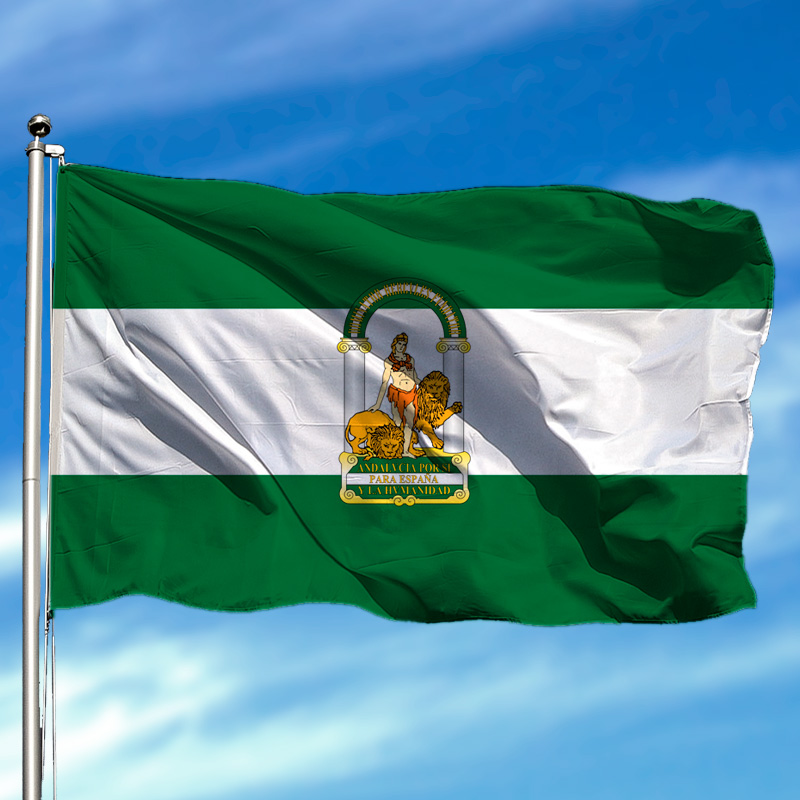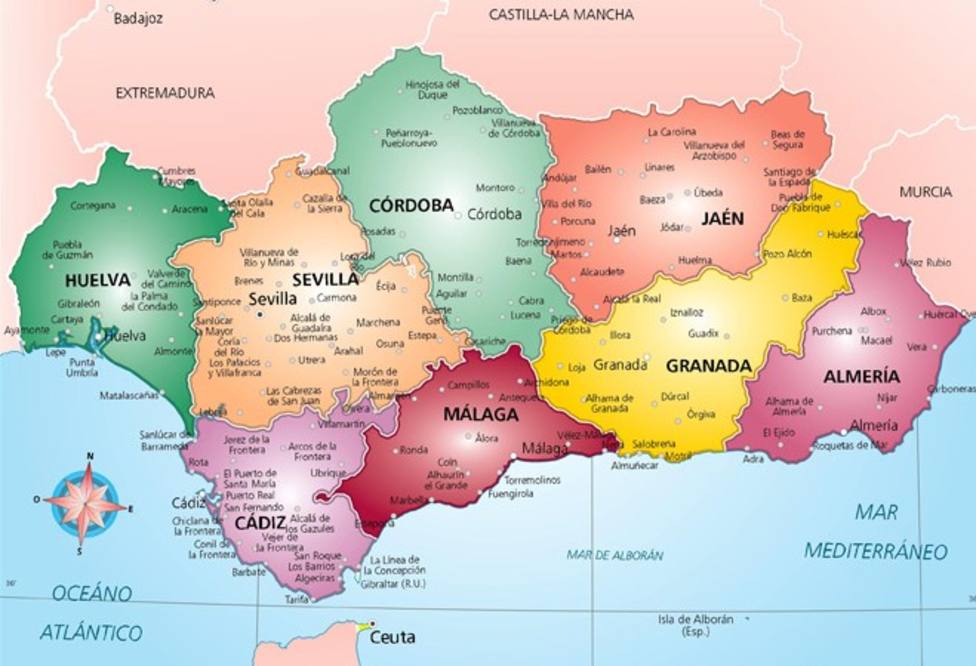
Recently Pablo de Ronda wrote about six of his dozen favourite towns and cities in Andalucía.
In this article he turns his attention to the remaining six: Almería, Granada, Huelva, Jaén, Tarifa and Úbeda.
Amazing Almería
Much under-rated as a city, Almería is in fact amazing.
It enjoys the best winter climate in the whole of Spain. According to the online travel agent www.loveholidays.com, Almería was ranked the brightest city for British people to escape the UK winter for a break in the sun. With a daily average of six hours and 18 minutes of sunshine between December and February, and highs of 16 C in January, the temperature rarely drops below 9 C.
The capital of the province with the only desert in Europe, Las Tabernas, and the most plastic „greenhouses“ (invernaderos), this city of just under 200,000 inhabitants lies on the coast and has a busy port.
The Alcazaba, a medieval fortress, is magical with superb views. It is the second-largest of all the Andalucían fortresses after the Alhambra in Granada.
The Cathedral-cum-fortress is really interesting, having been built in a mixture of architectural styles, predominantly Gothic and Renaissance. It dates from the 16th Century.
Other interesting places to visit are the Archeological Museum, the Civil War Museum (housed in tunnels used as air-raid-shelters while the city was being bombed by the German Luftwaffe on behalf of General Franco), the Photographic Museum and the Casa del Cine, which was a hotel where film stars who made movies in the nearby studios in the Las Tabernas desert stayed.
The nearby Parque Natural del Cabo de Gata is the largest protected coastal area in Andalucía and is a must-see. Unspoilt and beautiful.
Gorgeous Granada
I’ve visited Granada so many times that I don’t really need to go again, although I undoubtedly shall, since Granada City and its Alhambra Palace are truly gorgeous.
My first visit was in the late 1980s with my young family. We did the Generalife, the Alcazaba and the Alhambra, despite having one child in a buggy. We were knocked out, of course.
On subsequent visits with different people we’ve enjoyed the old town, the cathedral and the Sacromonte (gypsy quarter).
There is a Parador de Turismo in the grounds of the Alhambra. Despite being very popular and expensive, a girlfriend and I managed to get a room there in the mid 2000s. It was very nice indeed.
If you plan to visit the Alhambra, book online in advance to avoid lengthy queuing to get in.
Wonderful Huelva
Often referred to as the “ugliest capital in Andalucia”, Huelva is actually rather wonderful. This city of 145,000 people has surprisingly cool things to see if you just know where to look.
Huelva is located between two short rias though has an outlying spur including a nature reserve on the coast of the Gulf of Cádiz. The rias are of the Odiel and Tinto rivers and are good natural harbours.
While the existence of a pre-Phoenician settlement within the current urban limits since circa 1250 BC has been tentatively defended by scholars, Phoenicians established a stable colony by the 9th century BC.
Mines in the countryside send copper and pyrites to Huelva’s port for export. From about 1873, the biggest mining company, the British firm Rio Tinto, catered to technological breakthroughs on both sides of the Atlantic which needed high quality copper, such as for electrics and alloys.
Huelva acquired the status of city (ciudad) by means of a royal decree from 17 September 1876.
The ore smelting caused severe sulfur dioxide pollution and was frequently accompanied by protests by local farmers, peasants and miners.
Because of all this industrial activity the population increased dramatically to its current size.
Things to see and do include:
Exploring the Muelle del Tinto and the Barrio Reina Victoria, visiting the Cathedral, the Museum, the Church of San Pedro, Casa Colon, the Christopher Columbus Monument and the defunct railway station. You can take a trip to the Odiel Nature Reserve or spend a beach day at Matalascañas or Punta Umbría. Further afield is the La Doñana Nature Reserve.
In the city there are some excellent tapas bars and seafood restaurants.
Although Huelva City is difficult to get to by public transport, it’s worth the drive, if you stay over. There is a stunning parador nearby, at Mazagón, right in the heart of La Doñana Nature Reserve or you can look for a cheaper option in town.
Heady Jaén
Jaén is stunning. At 600 metres above sea level it is also heady, and hot, hot, hot. Not as hot as Sevilla, but close.
Its sandstone buildings make it look and feel significantly different to the other seven provincial capitals of the Andalucía region.
We stayed in the parador which is housed in St Catherine’s Castle (Castillo de Santa Catalina), a major monument in Jaén. which sits on the top of a hill overlooking the city. Previously there had existed a fortress of Arabic origin, of which some remains still exist. The current construction is of Christian origin, raised after the conquest of the city by Ferdinand III of Castile in 1246.
La Catedral is an important Renaissance-style cathedral. Construction began in 1570 and was completed in 1802. Due to the length of time of its construction, different artistic styles can be detected, the most prominent being Renaissance. It aspires to be listed as a UNESCO World Heritage Site:
The Baños Arabes (Arab Baths) are among the largest Islamic bathhouses preserved in Spain. These Arab baths had the function of purifying all the visitors who entered the city. However, nowadays they are not in use, except as a historical tourist attraction.
Other important landmarks are the Museum of Arts and Popular Customs, the International Museum of Naïf Art, San Andrés's Chapel, the Provincial Museum of Jaén (which shelters an important collection of Iberian archaeological remains), Saint Ildefonso's church and La Magdalena church.
Not far from Jaén is the beautiful town of Úbeda (see below).
Tantalising Tarifa
As I’ve written previously, I’ve been to Tarifa umpteen times. As the place where the Mediterranean Sea meets the Atlantic Ocean, it’s a go-to-visit whenever we have family and friends to stay where we live, up in Ronda.
We’re blown away every time! Literally! It’s very windy. Not for nothing is Tarifa the "wind-surfing capital of Europe".
All these surfers and campers lend Tarifa, a small town with a resident population of ca. 18,000, a bohemian and trendy feel, yet the town retains its North African atmosphere. Tarifa is tantalising, a place where several worlds collide.
La Isla is a small island that is connected to the mainland by a 30m long bridge. This island and its connecting bridge are considered the official divide between the Atlantic and Mediterranean coasts of Andalucía.
At exactly 36 degrees latitude, Tarifa is the southernmost point of continental Europe. The only parts of Europe further south are islands - including the Greek island of Gavdos, which is the southernmost point of Europe. The North African capital cities of Algiers and Tunis actually lie further north than Tarifa.
Historical landmarks in Tarifa include the well-preserved Guzmán castle, near the port; the remains of the medieval walls; and the Church of St Matthew.
The ruins of the Roman city of Baelo Claudia, the best ruins I’ve ever seen, are located at nearby Bolonia, our favourite beach.
Unbelievable Úbeda
I love Úbeda. It’s truly unbelievable. The first time I visited was during a mini-tour of paradores in 2005 with my then girlfriend, Maude. We took in the paradores at Cazorla, Granada, Jaén and Úbeda.
Úbeda is about the size of Ronda, 30-plus thousand population, and like my "home town" up in the hills above Marbella, feels like a village.
Built of the same stone as Jaén and nearby Baeza, it is delightful to gaze at. Everywhere is in walking distance.
The parador itself is a monument, a former palace. It was the first palace to be converted into a parador. It was originally built as the residence of the chaplain of the funeral chapel of El Salvador and is located in a central square where it shares space with some of the city's most outstanding monuments. The building’s Renaissance architecture is notable for its façade and splendid central courtyard, which is one of the most beautiful in Úbeda. The large windows on the façade bathe the interior, its elegant rooms and majestic halls in bright light.
Together with the nearby town of Baeza, Úbeda has been designated a UNESCO World Heritage Site. A well-deserved accolade.
***
 That concludes my overview of my dozen favorite large towns and cities in Andalucía.
That concludes my overview of my dozen favorite large towns and cities in Andalucía.
There are, of course, many smaller municipios, including the so-called pueblos blancos.
I like Baeza, Bolonia, Cazorla, Cómpeta, Cortes de la Frontera, El Colmenar, Frigiliana, Gaucín, Jimena de la Frontera, Jimera de Líbar, Mijas Pueblo, Monda, Montejaque, Nerja, Ojén, Olvera, Setenil de las Bodegas, Torre del Mar, Torrox Pueblo and Zahara de la Sierra.
These are all in Cádiz, Jaén and Málaga provinces. But there are surely many more that I haven’t discovered yet in the other five provinces of the region.
Watch this space …..
Further reading:
The Cities of Andalucia Part I
© Pablo de Ronda
Additional material:
www.andalucia.com
www.loveholidays.com
Tripadvisor
Wikipedia
Tags: Alcazaba, Alhambra, Almeria, Andalucía, Arab Baths, Archeological Museum, Atlantic, Baeza, Baños Arabes, Bolonia, Cádiz, Casa del Cine, Cazorla, Civil War Museum, Cómpeta, Cortes de la Frontera, desert, El Colmenar, Frigiliana, Gaucín, General Franco, Generalife, Granada, Huelva, International Museum of Naïf Art, Jaén, Jimena de la Frontera, Jimera de Líbar, La Magdalena church, Las Tabernas, Luftwaffe, Málaga, Matalascañas, Mediterranean, Mijas Pueblo, Monda, Montejaque, Museum of Arts and Popular Customs, Nerja, Odiel, Ojén, Olvera, Pablo de Ronda, Photographic Museum, Provincial Museum of Jaén, Punta Umbría, Rio Tinto, Ronda, Sacromonte, Saint Ildefonso's church, San Andrés's Chapel, Setenil de las Bodegas, Sevilla, Tarifa, Tinto, Úbeda, Torre del Mar, Torrox Pueblo, UNESCO World Heritage Site, Zahara de la Sierra